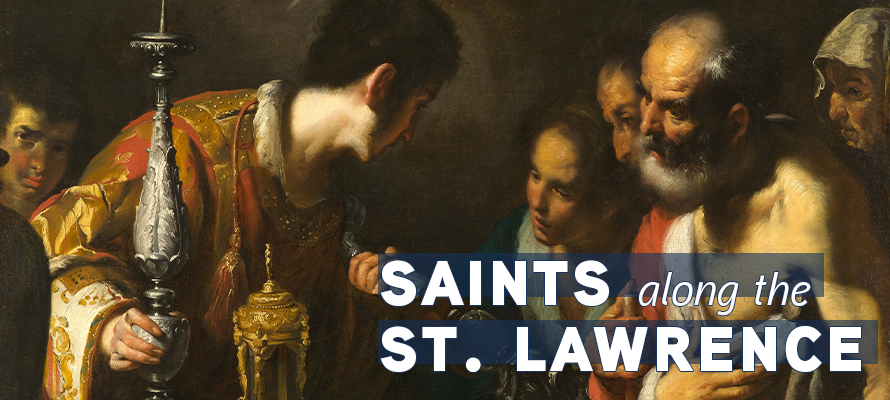
The Gulf of St. Lawrence was named after the saint we celebrated earlier this week by the French explorer Jacques Cartier as he first sailed into the gulf on August 10, 1535, the feast of the martyr St. Lawrence of Rome. It is fitting then, to explore today some of the other saints now connected with the Gulf of St. Lawrence as well as the St. Lawrence River, and whose shrines are now pilgrimage sites for those wishing to honor and venerate them.
But first, a little about St. Lawrence. He was one of the seven deacons of Rome under Pope Sixtus and served the poor with great faith and devotion, referring to them as “the riches of the Church.” His remains are located in Rome, in the Basilica of St. Lawrence Outside the Walls (San Lorenzo Fuori le Mura). On display as well is the grate on which he was martyred. This method of his martyrdom has led to what is one of the most famous quotes of St Lawrence. He headed off to be martyred quite cheerfully and more than willingly. His death in 258, during the time of severe persecution of the church, reflected a life lived robustly and without reservation. As he lay on the grate burning to death, he is recorded as having cried out, “You have me well done on one side, turn me over.” This anecdote, along with his service as deacon in Rome, has led him to be named the patron of the poor, cooks, and (more recently) comedians.
St. Lawrence’s example of holiness and love of the poor can be seen reflected in the works of early Canadian and North American saints who served along what is now known as the St. Lawrence River.
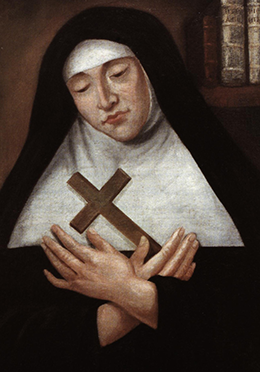
The earliest of these saints, Saint Marie de l’Incarnation lived from 1599-1672. Though she felt called to the religious life from an early age, she followed the wishes of her parents and married instead. She was widowed just two years later, which did allow her to eventually pursue the religious life. She entered the Ursulines in 1631 and through interpretation of her visions under direction of her spiritual director sought missionary work in Canada – then still a colony under French rule and known as “New France.” In 1639 she and a few other women arrived in Canada and established a convent of Ursulines. They built and ran the first school for girls in Canada and established the Ursuline Monastery of Quebec, now on the list of national historic sites of Canada. As part of the missionary spirit, the sisters served both the daughters of French colonists as well as girls from the native Canadian tribes (who were educated at no cost to themselves or their families). After her death, she was buried in the Ursuline chapel in the convent she helped to establish.
Saint Marguerite Bourgeoys was born in France in 1620 and felt a call to dedicate her life to Jesus from a young age. At the age of 15 she became a lay member of the Congregation of Notre Dame in her hometown. It was a teaching order and she was drawn to teach all who needed it – whether they could afford to live in the cloister or not. It was partially for that reason Marguerite did not enter the cloistered religious life. In 1653, she left France at the request of the Governor of Montreal to set up a congregation to serve the colonists of New France. Marguerite recruited other teachers and began the first public school in Montreal. Together the women began to live out the life of a religious congregation. She wanted to be established as a recognized order in the Church, but her bishop wanted them to be cloistered in order to do so. After many years of petitioning France and other bishops in order to keep the order “secular” (meaning non-cloistered) and serve beyond the convent, the community was officially recognized and established in 1698, just two years before Marguerite’s death. Her community still serves throughout Canada today and Saint Marguerite is buried in Montreal at Notre-Dame-de-Bon-Secours Chapel, just steps from the St. Lawrence River.
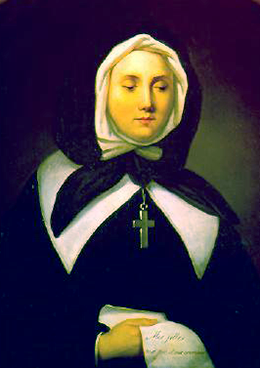

As a French colony, the Catholic Church in Canada was missionary territory for the French clergy and religious orders, such as the Jesuits. In 1658, the future Saint Francois de Laval was appointed Apostolic Vicar of New France and set sail for the colony. In 1674, Quebec became its own diocese (initially encompassing all of Canada) and Francois became its first bishop. During his tenure, he sought to unite the Catholics spread far and wide across the vast diocese and established the first seminary in Canada to train up other priests to serve the people. Saint Francois de Laval died in 1708 and is buried in the Cathedral of Notre-Dame de Quebec.
In 1656, in what is now Upstate New York, the “Lily of the Mohawks” was born. Her Algonquin mother and Mohawk father sadly died of a smallpox outbreak, which left the future Saint Kateri Tekakwitha blind and pock-marked. Though her mother was a Catholic, the rest of her family was not, and Kateri was first introduced to the faith by the Jesuit missionaries, who baptized her in 1676. Shortly thereafter, she moved north to the St. Francis Xavier mission along the St. Lawrence River, where she received her First Holy Communion on Christmas Day in 1677. She died an early death, at only 24, and those who witnessed it saw her face transformed, the scars gone, shortly after her passing. She was buried alongside the river and her tomb is now in the church at the mission, which is located within the Mohawk community of Kahnawake. In 2012, she became the first canonized Native American saint.
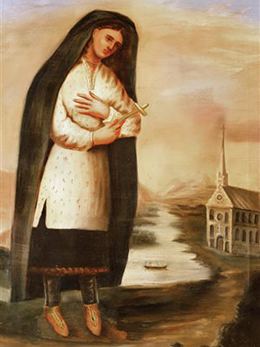
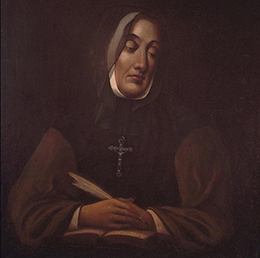
Saint Marguerite d’Youville was born in 1701 and always had a love for the poor and needy. She married and raised a family, though her husband left her a widow after just a few years. In 1737, having served the sick and poor throughout her widowhood, she took private vows and laid the foundation for the congregation of the Sisters of Charity of Montreal (the Grey Nuns). She took over management of the General Hospital of Montreal in 1747, cared for the poor and orphaned. After a long life of service, Marguerite died in 1771. The funeral chapel with her tomb is in the Sanctuary of Saint Marguerite d’Youville just outside Montreal on the banks of the St. Lawrence River. Her renown extends beyond the Catholic Church, as she was inducted into the Canadian Medical Hall of Fame in 2003.
Blessed Marie-Rose Durocher wanted to serve others through religious life, intending to follow in the footsteps of her older siblings. Due to her frail health, she was unable to enter the Congregation of Notre Dame (which was founded by St. Marguerite Bourgeoys, above, and to which her sister belonged), so she served one of her priest brothers in his parish in Montreal as housekeeper, hostess, and parish worker. After years there, she heard about a teaching order that was coming from France to serve in Canada and sought to enter their novitiate. When that planned establishment never happened, Marie-Rose was approached to begin the order in Canada herself. After some persuasion, she agreed, and after professing her vows in 1844, Sister Marie-Rose became the mother superior of the newly-established Sisters of the Holy Names of Jesus and Mary. Upon her death in 1849, she was buried in the Chapelle Marie-Rose in the Co-cathedral of St. Anthony of Padua in Longueuil, a village along the St. Lawrence just outside Montreal.
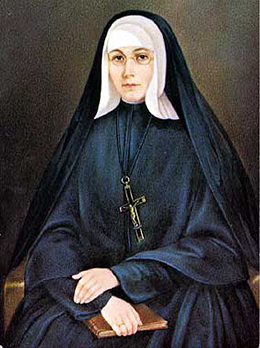
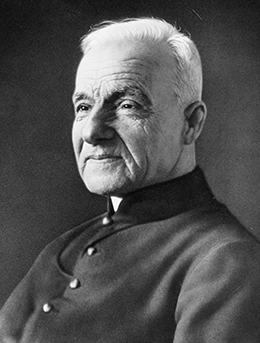
A more recent Canadian saint is Saint André Bessette, buried in the oratory he founded to encourage increased devotion to St. Joseph. It sits atop Mount Royal (the namesake of Montreal) overlooking the St. Lawrence River. St. Andre was born in 1845 and though he felt called to the religious life, he was initially denied entry to the Congregation of the Holy Cross due to poor health. Finally, in 1870, he entered the novitiate, but, due to continued health issues, served merely as the doorkeeper of the congregation. There he greeted visitors and tended to their needs, praying with them and assisting them as best he could. A number of healings were reported after praying with Brother Andre, and his reputation spread far and wide. A humble soul, he never took credit for these healings, attributing them only to God through the intercession of St. Joseph. After the visitors grew too numerous for the lobby of the congregation to hold, Brother André moved his ministry across the street and eventually oversaw the building of the St. Joseph Oratory. Over a million people paid their respects after his death in 1937, braving the harsh Canadian winter to honor this man of prayer. Pilgrims today can pay their respects in the main chapel of the oratory, underneath which lies the crypt of St. André Bessette.




